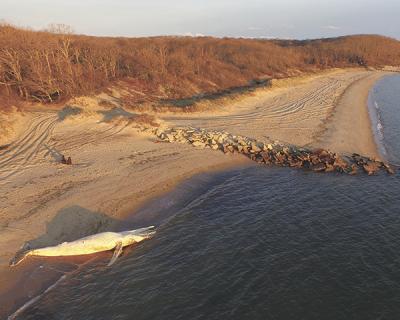Last Stop For Dead Whale Will Be Dump

The 29-foot-long carcass of a dead humpback whale floated around Gardiner’s Bay and ran aground off Promised Land over the weekend before being removed in a complicated process that will cost the town a few thousand dollars. It is one of three humpbacks that were found dead in recent days in Northeast waters.
A bayman first alerted East Hampton Town Marine Patrol to the dead animal on Sunday morning, according to Ed Michels, the chief harbormaster. Coast Guard Station Montauk searched for the whale, but did not locate it until Sunday evening, he said. They went back on Monday morning and the carcass appeared to be stuck in the shallow waters of the bay. Belly up, with seagulls pecking at it, it was about 500 feet from shore between Devon Yacht Club in Amagansett and the Multi Aquaculture Systems fish farm.
Mr. Michels briefed Town Supervisor Larry Cantwell, offering two options: Leave it alone and let Mother Nature run its course or try to tow it to shore and dispose of it, a process that comes with a price tag.
At Mr. Cantwell’s request, the Riverhead Foundation for Marine Research and Preservation hopped a ride with Marine Patrol officers on Tuesday to determine if the carcass would even withstand being towed. Mr. Michels had raised concerns that the body may have been too far decomposed to hold up under the strain of a tow rope.
Mr. Cantwell said Tuesday afternoon that there was reason to believe the whale’s body might come adrift due to the strong east winds and rising tide. “At that point it could have washed up anywhere,” he said. “I would rather be able to control the situation to the extent that we can and know it can be taken care of.” It would be more trouble to deal with it if it were to wash ashore on rocks or in an area with no beach access, he said.
The decision was made that afternoon to move it to the beach, where a necropsy could be performed in an effort to determine what caused its demise.
The whale was towed by a Marine Patrol boat using a line that was secured to one of its fins, Mr. Michels said. It was taken to Little Albert’s Beach in Amagansett, and then a line was attached to the carcass so it could be secured from the shore. Kim Durham, a biologist with the Riverhead Foundation, was aboard during the effort.
The Riverhead Foundation’s biologists returned yesterday morning to perform the necropsy, according to Rachel Bosworth, a spokeswoman for the foundation. Samples will be sent to a pathologist. Results can take anywhere from a few weeks to a few months. The whale, a female that was approximately 3 years old, showed some evidence of blunt force trauma, Ms. Bosworth said.
Humpback whales can grow to 60 feet and weigh between 25 and 40 tons. A federally endangered species that was once hunted to the point of near extinction, the whales still face several threats, according to the National Oceanic and Atmospheric Administration, including entanglement in fishing gear, ship strikes, noise pollution, and even harassment from whale watchers. A ship strike could be a cause of blunt force trauma.
Only a portion of the mammal was dissected and taken for testing. The rest of it was to be carted to the town dump, where it would be incinerated, according to Town Highway Superintendent Stephen Lynch.
Patrick Bistrian Jr. Inc., which has a town contract to provide use of various machinery, was to remove the whale after the necropsy is completed, according to Mr. Lynch. The cost would be “a few thousand dollars, nothing astronomical,” he said.
The foundation received information from NOAA that two other humpback whales, one in Newport, R.I., and the other in Marshfield, Mass., were found dead in recent days. The Mystic Aquarium was investigating the death of the Rhode Island whale, and the New England Aquarium was looking at the whale in Marshfield, Ms. Bosworth said. “At this time it is unclear whether any of these occurrences are related in any way, and all organizations will be reporting their findings to NOAA,” she said.
